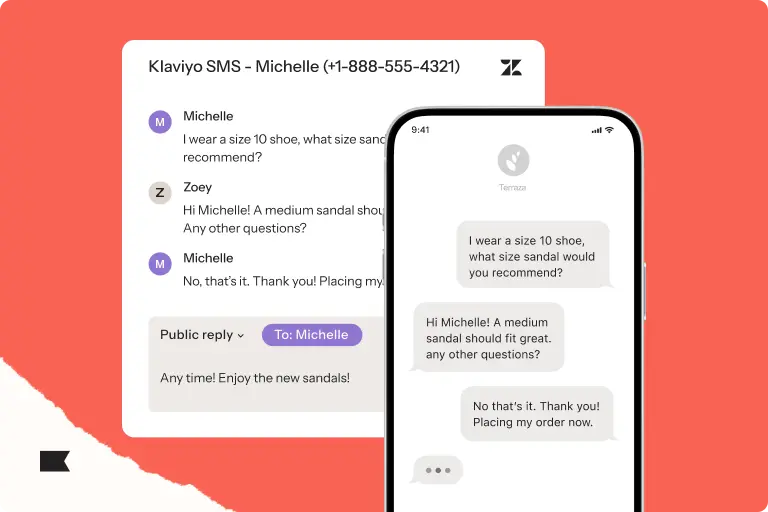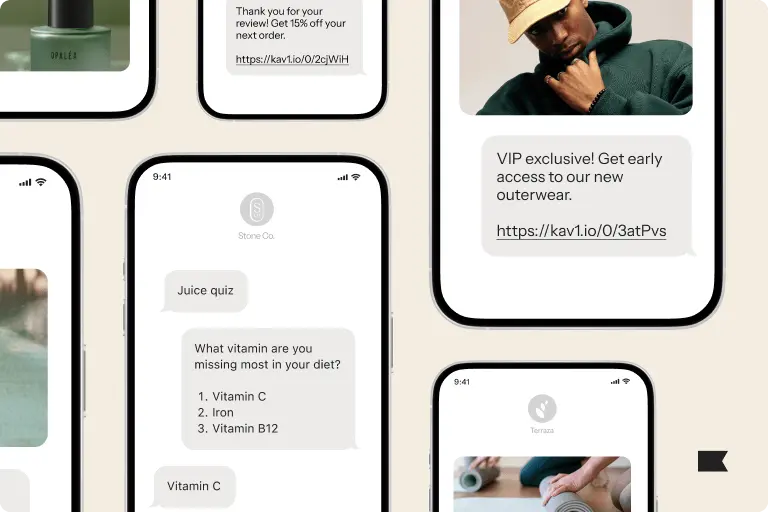100+ SMS marketing statistics—and how they can inform your SMS marketing strategy
More people than ever before are open to receiving text messages from brands.
But it’s not good enough to know that in vague terms.
Klaviyo recently teamed up with subscription and recurring payments platform Recharge in a global survey of 8,781 people to find out:
- How text messages influence people to buy products
- The types of text messages people want from brands
- How brands can get the most out of their SMS marketing strategy
To meet our research criteria, survey respondents needed to conduct at least half their shopping online while doing it at least twice a month. We surveyed people from North America, Europe, and Asia-Pacific (APAC) to help brands develop international SMS marketing strategies.
Read on to get the stats from the study that will help you market smarter over SMS.
Top SMS marketing stats in 2024: SMS speeds up time to purchase
While consumers generally tend to prefer email over SMS, the data is clear about one thing: a phone number is an extremely lucrative piece of data for brands to collect.
Here are a few top findings from our research that prove the point:
72% of people have made a purchase after receiving a text from a brand. For Europe, that number is slightly higher at 74%; for APAC, slightly lower at 69%.
86% of respondents made 2+ purchases in the last year from SMS messages, up from 55% in 2022. Within that group of respondents, 30% said they made 4+ purchases from SMS in the last year, and almost 10% made 6+ purchases.
65% of people who made an SMS purchase in the last year said it was something they were planning to buy in the near future or in a few months—and they ended up buying the item earlier than they planned to because of a promotional text message. This is up from 60% of people who said the same in 2022.
14% of respondents made a purchase when they weren’t thinking about buying at all.
SMS list growth: how to get more subscribers
Discounts drive SMS sign-ups. But it’s also not that simple.
When we compare what people say would make them more likely to subscribe to SMS to why they actually sign up, it seems like brands can circumvent discounts if people are already loyalists.
The importance of offering SMS sign-up options at check-out and in post-purchase email flows becomes obvious when you consider that 62% of people are more likely to subscribe to SMS after they’ve made a purchase—up from 50% in 2022.
What increases the likelihood of subscribing to SMS
- Being offered a discount: 59%
- Being able to ask questions and receive fast responses via text message (conversational SMS): 39%
- Being offered a unique product or experience: 38%
- Personalized messages: 33%
- Knowing there’s a person on the other end of the message: 31%
- Being able to communicate with favorite brands via text message: 28%
- Being able to edit or update an upcoming subscription order: 27%
- Being able to repeat purchase via text message (without providing payment info): 23%
- Being able to repeat purchase via text message by providing payment: 20%
Why people actually sign up for SMS
- It’s a brand they love: 39%
- They’re about to make a purchase and want to get a discount: 38%
- They want to get messages about their order status: 38%
- They purchase from the brand frequently: 37%
- It’s a brand they want to purchase from when there’s a sale: 35%
- They want early access to sales or new products: 34%
- They want notifications when specific products are on sale or back in stock: 29%
- They want reminders about upcoming orders or appointments: 29%
- It’s a brand they spend a lot of money on: 28%
- They want to stay up-to-date on the latest news: 24%
- They want to edit or update their upcoming subscription order without logging in to their account: 21%
SMS communication preferences: frequency and time of day
If you’ve ever been afraid you’re sending too many text messages, odds are you’re not.
While you still need to be mindful of frequency—61% of people said they unsubscribe from SMS because they receive too many messages—72% of people are willing to receive a text at least once a week, and almost half of those (45%) are willing to receive a text more than once a week.
Not only that, but 50% of respondents in North America said they expect to see a text from a brand at least once per week. This is why Klaviyo recommends sending text messages regularly once you start—if you don’t, your subscribers may forget why they signed up in the first place and end up unsubscribing.
Acceptable SMS frequency from brands
- A few times a week: 32%
- Once a week: 27%
- A few times a month: 16%
- Once a day: 13%
When to send text messages to convert subscribers
Your SMS marketing strategy is about quick communication and, ideally, fast conversion. This is why, unlike other “always on” marketing channels, send time really, really matters with SMS.
But send time doesn’t just matter for conversion—it also matters for compliance. So even though most people (45%) make purchases via SMS in the evening, brands must keep quiet hours in mind.
The TCPA prohibits any telephone solicitation (including text messages) anytime before 8:00 am and after 9:00 pm in the recipient’s time zone, but certain states have more restrictive rules. Sending based on time zone can help you stay compliant.
With all that in mind, here’s when people are most likely to make a purchase via SMS:
- Evening: 45%
- Afternoon: 25%
- Midday: 13%
- Morning: 9%
- Late night hours: 8%
And here’s what people are most likely doing when they make that SMS purchase:
- Watching TV: 52%
- Having a snack or drinking a beverage: 28%
- Commuting: 7%
- Working: 6%
- Doing something else: 5%
- Cooking: 3%
SMS message types: what people want to receive…and what they don’t
In general, the types of text messages people want to receive from brands can be broken down into 3 categories:
Transactional SMS messages, such as order confirmations, shipment and delivery confirmations, back-in-stock notifications, and product subscription reminders
Fast responses, unique-to-them experiences, birthday deals, and other personalized messages
Discounts and sales
Top 5 SMS messages people want to receive more often
- Shipment and delivery confirmations: 51%
- Coupons or promotional codes: 42%
- Order confirmations: 39%
- Birthday deals: 37%
- Promotion and sales announcements: 32%
Top 5 exclusivity-related SMS messages
- Birthday deals: 34%
- Loyalty program offers and benefits: 33%
- Early access to sales, product drops, and other VIP experiences: 31%
- Coupons or promotional codes: 31%
- Promotion and sales announcements: 26%
Top 5 SMS messages people want to receive less often
- Abandoned cart reminders: 37%
- Low inventory alerts: 34%
- Messages based on actions taken: 33%
- Interesting or helpful content with no sales component: 32%
- New product announcements: 32%
What makes people unsubscribe from SMS?
- Receiving too many messages: 61%
- Receiving the same message too many times: 57%
- Messages that don’t have a purpose: 53%
- Receiving messages on topics or products they’re not interested in: 46%
- Messages that don’t seem intended for them: 44%
- Receiving the same message by email and SMS: 37%
- Receiving messages at inappropriate times: 35%
- Only receiving messaging regarding discounts and sales: 17%
SMS subscription and conversion rates: how SMS influences brand loyalty
Our research found that brand loyalty and SMS engagement reinforce each other: while 39% of respondents have signed up for SMS because they love a particular brand, 59% are more likely to engage with a brand when they’re subscribed to SMS.
Number of brands people are subscribed to via SMS
- 2-3 brands: 45%
- 4-5 brands: 29%
- 1 brand: 12%
- 6-7 brands: 8%
- 7+ brands: 7%
Frequency of purchasing in the past year after a text
- 2-3x: 56%
- 4-5x: 21%
- Once: 14%
- More than 6x: 9%
Email and SMS: segmenting based on preferred channel
While35% of people find receiving the same message via email and SMS to be very helpful,another 27% say it depends on the message.
This is why an integrated email-SMS strategy is so important—because people have different channel preferences for different types of messages.
Here’s how those preferences break down:
- Shipment and delivery confirmations: 32% SMS vs. 46% email
- Birthday deals: 26% SMS vs. 47% email
- Order confirmations: 24% SMS vs. 54% email
- Coupons or promotional codes: 23% SMS vs. 50% email
- Back-in-stock notifications: 23% SMS vs. 44% email
- Early access to sales, product drops, and other VIP experiences: 22% SMS vs. 46% email
- Promotion and sales announcements: 21% SMS vs. 48% email
- Edit or update an upcoming subscription order: 21% SMS vs. 50% email
- Product subscription reminders: 20% SMS vs. 47% email
- Loyalty program offers and benefits: 20% SMS vs. 51% email
- Low inventory alerts: 18% SMS vs. 37% email
- Abandoned cart reminders: 18% SMS vs. 39% email
- Special announcements like upcoming events: 18% SMS vs. 46% email
- Messages based on actions: 18% SMS vs. 41% email
- New product announcements: 15% SMS vs. 47% email
- Interesting or helpful content with no sales component: 15% SMS vs. 44% email
SMS marketing statistics by region
To help brands develop international SMS marketing strategies, we surveyed people from North America, Europe, and APAC. Here are some of the most notable regional differences to keep in mind:
More North American consumers prefer SMS
SMS marketing is most essential in North America, where 30% of people say it’s their most preferred channel (compared to 24% globally).
North Americans are also most likely to purchase before midday, although it’s not a given—which means brands that rely on SMS purchases in North America should A/B test send time more frequently than when they send to Europe and APAC regions.
Finally, while North Americans are most open to receiving more than one SMS message per week, they also prefer “jobs to be done” transactional messages over other types of messages.
Europeans are most likely to repeat purchase through SMS
Europeans have the highest brand loyalty of any region: 61% say they’re loyal to 3 or more brands, compared to 45% of North Americans and 48% of APAC consumers.
Europeans also subscribe most frequently to SMS messages—46% subscribe to 4 or more brands, compared to 38% of North Americans.
Conversion from first-time buyer to repeat purchaser works best in Europe, too. Europeans are most likely to have made an SMS purchase 4-5x in the last year (23%), compared to 18% of North Americans and 17% of APAC consumers.
APAC consumers subscribe to SMS for discounts and custom experiences
Discounts are more important for SMS sign-ups in the APAC region—66% of respondents say a discount would increase their likelihood of subscribing, compared to a global average of 59%. People from this region also expect the least amount of SMS messages—ideally only 1x a week.
APAC consumers are also most likely to want differentiated email and SMS experiences: 40% say receiving the same email and SMS message is repetitive, compared to 32% of North Americans and 31% of Europeans.
Win more SMS customers with Klaviyo
Ready to put these stats to work? With high customer ratings on both G2 and TrustRadius, Klaviyo is “the leader of the industry” for SMS marketing, says Elliot Scott, founder and CEO of London-based retention agency ElliotDigital—and it’s the only platform his agency uses for email and SMS.
Use Klaviyo SMS marketing to:
- Grow your SMS list with a variety of touchpoints: targeted sign-up forms, QR codes, consent at check-out, and AI-powered forms display optimization.
- Integrate SMS messages and email with advanced segmentation options.
- Send personalized messages and create custom experiences with hyper-specific audience targeting.
- Make sure you’re compliant with regional quiet hours via time zone sending.
- Move first-time buyers to repeat purchase with personalized campaigns.
- Send table stakes transactional SMS messages for a stellar post-purchase experience.



